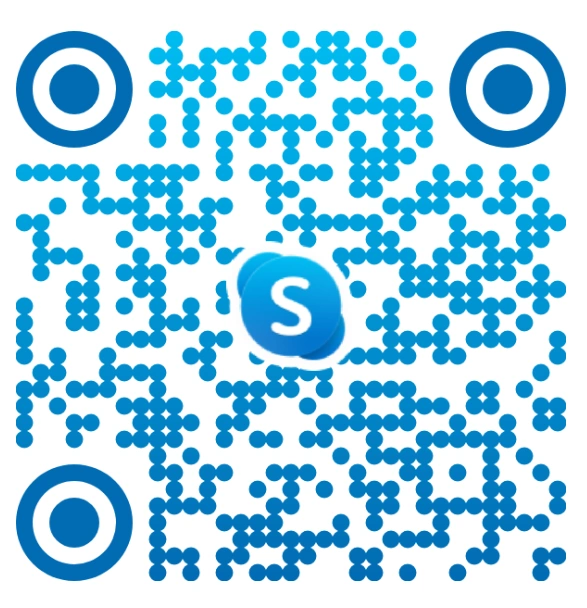How to Develop a Health Insurance Application? Cost, Key Features & Process
Developing a health insurance app may seem daunting, but trust us, it’s not rocket science. In fact, it’s more like building a sandwich – you just need to know what ingredients to put in. So, in this blog, we’ll show you how to develop a health insurance app that’ll help you to fascinate your targeted audiences.
Moreover, you need to understand that a health insurance app can provide customers with easy access to insurance policies, medical information, and a range of other services, making it a valuable asset for both insurance providers and their customers.
In this blog, we will discuss the key steps involved in developing a successful health insurance app and offer some useful tips for selecting the right development partner.
Overview of the Global Health Insurance Market
Here are some statistics that will help to understand about the health insurance global market. Below statistics showcase the impressive growth of the health insurance market.
- The health insurance sector is projected to expand at a compound annual growth rate of 5.5% between 2021 and 2028 as reported at fortune business insights.
- A significant number of 29.6 million Americans are without any health insurance coverage, indicating an extensive untapped market.
- Approximately 26% of the world’s insurance premiums are for health insurance.
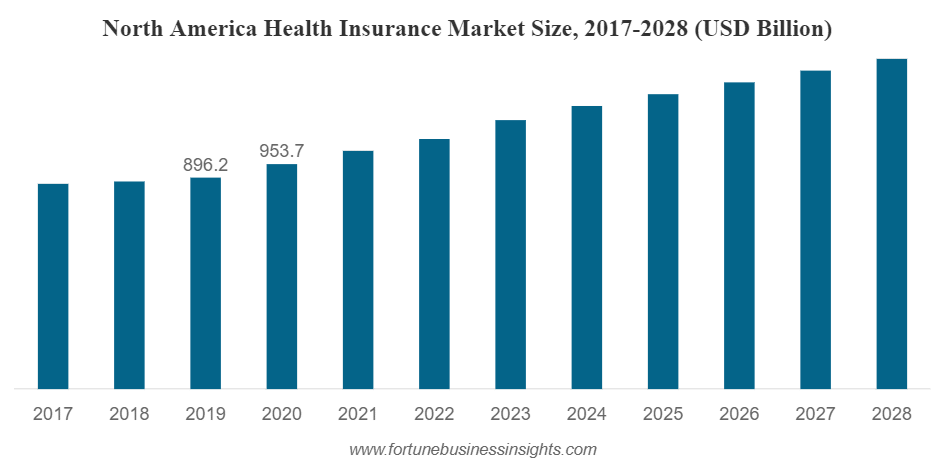
Top 6 Health & Medical Insurance Apps in 2023
All of these apps are designed to provide convenience and ease of access to their users. These latest applications will support making it easier to manage their health insurance policies, find healthcare providers, track their claims and access various other features related to their healthcare needs. These applications also support functions of the fitness sector & other sectors related to the healthcare industry:
1. mYCigna
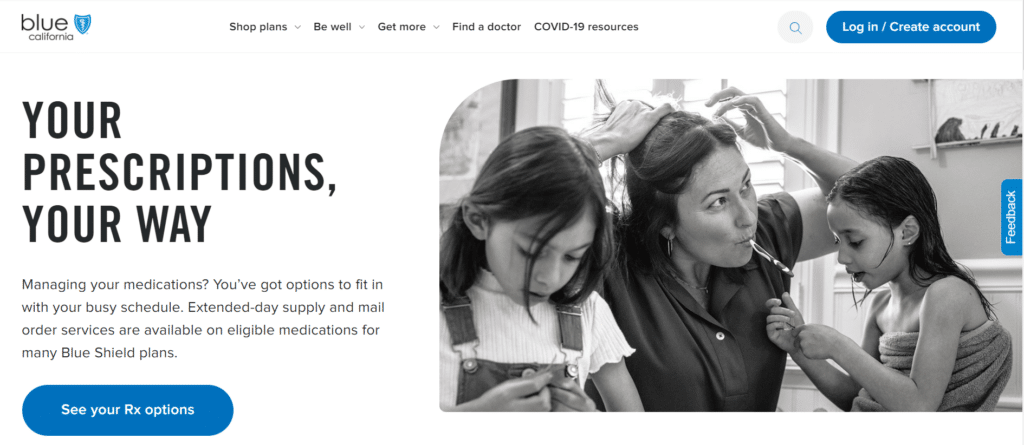
The life insurance company allows users to manage their insurance policies, track their investments, pay premiums and access various other features related to their life insurance policies. Users can even manage their digital cards and track the claim of their insurance with the in-built application services.
2. Aetna
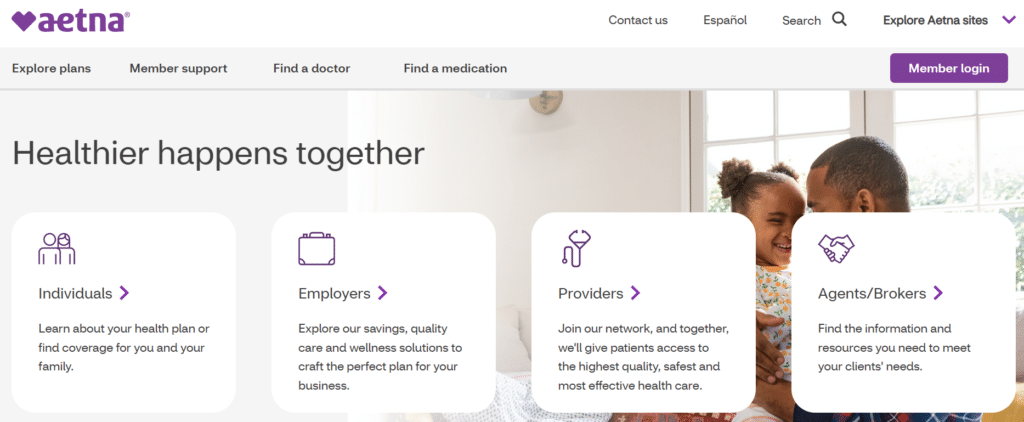
Aetna Inc. is a US-based company that provides managed health care services and sells various types of health insurance and related services, including medical, dental, behavioral health, long-term care, and disability plans. These insurance plans are mainly offered to employees through their employers’ insurance and benefit programs, as well as through Medicare. The company became a subsidiary of CVS Health on November 28, 2018.
3. Centene Corporation
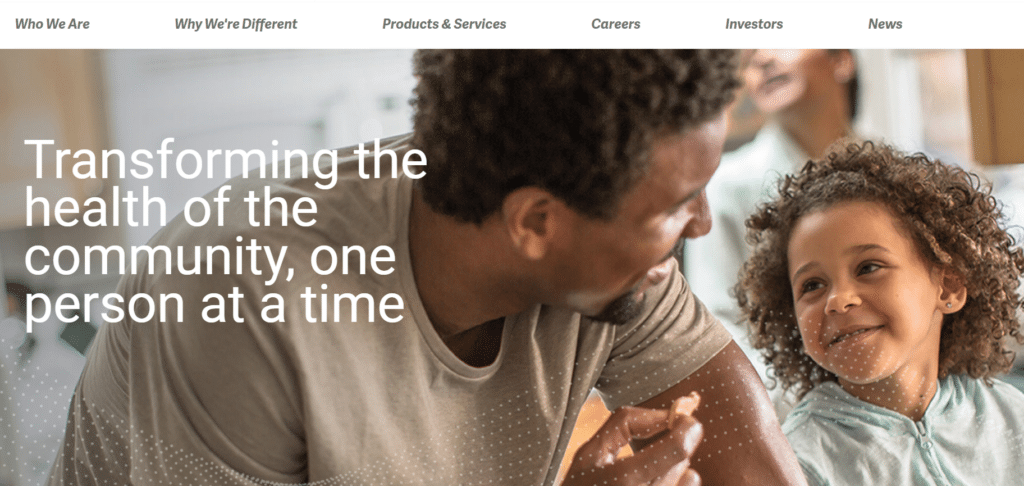
The company helps people to live healthier life by suggesting specific health plans. They also publish articles and health information on a frequent bases to make sure that all people should engage with the latest healthcare pillars. The company provides “Whole Health Solutions”, “State & National Health Solutions” and many more.
4. Oscar Health
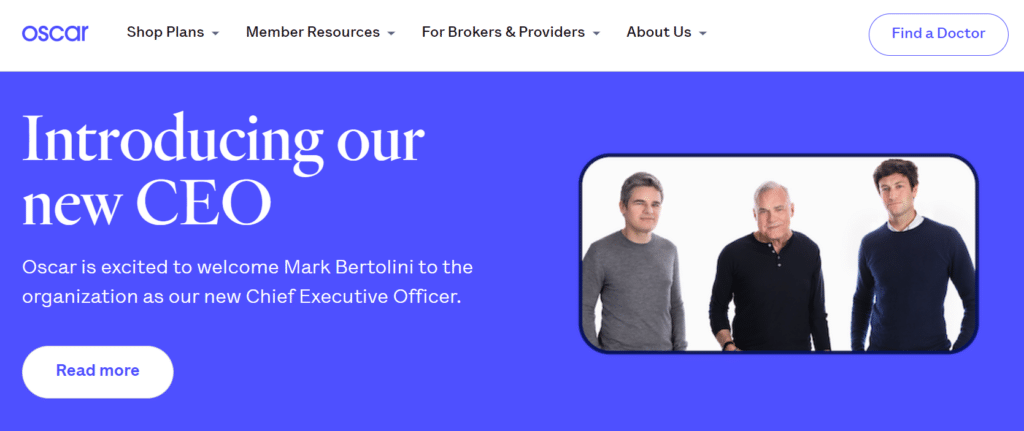
Oscar Health is a US-based health insurance company that offers a mobile app to its customers for managing their insurance policies, finding healthcare providers, tracking their claims, and accessing various other features related to their health insurance.
5. Medisafe
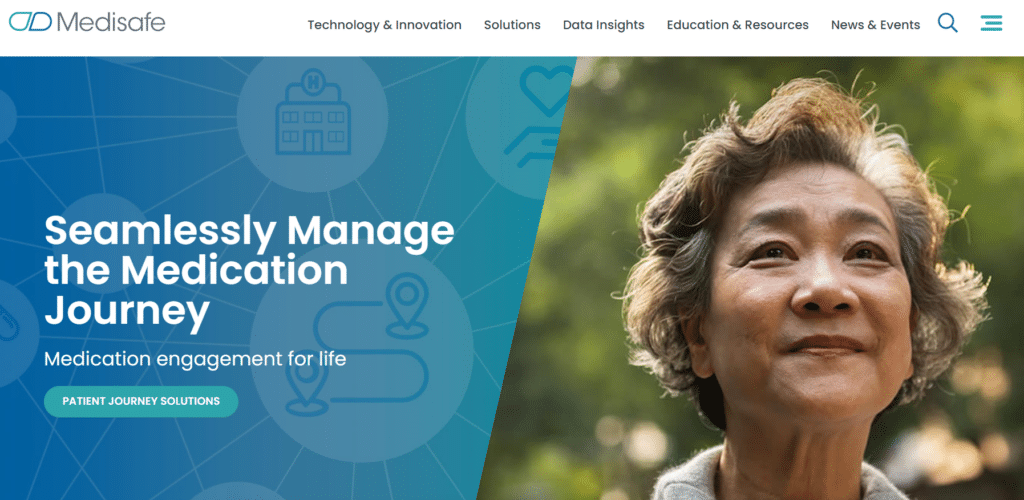
Medisafe is a medication management app that allows users to keep track of their medications, set reminders for their dosage, and receive alerts when it is time to refill their prescriptions.
6. HCSC
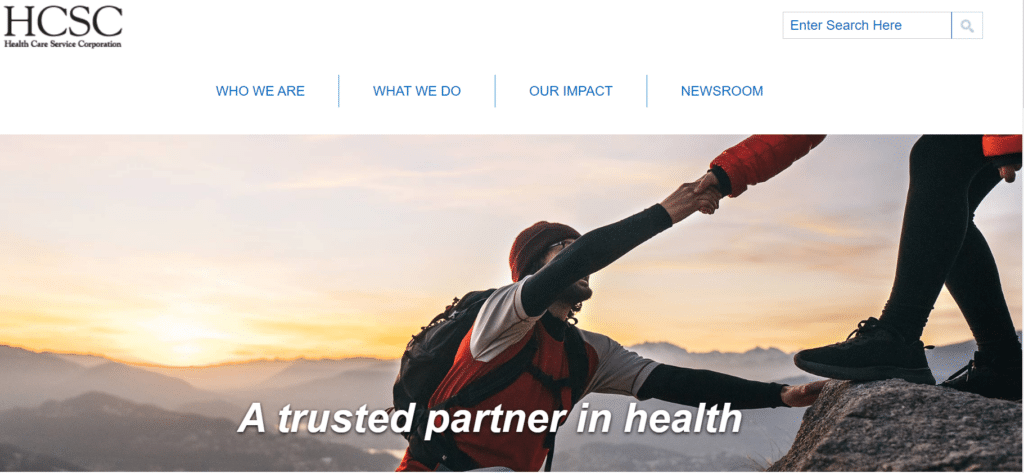
HCSC is a healthcare company that allows users to opt for different well-being plans and care for their family members. Fortune Magazine America’s Most Innovative Companies, Forbes Best Employers for Women, CIO 100 Awards, Modern Healthcare Influential People in the Healthcare and many more.
Read More: Healthcare Web Development
3 Key Pillars For Health Insurance Apps
The process of insurance app development can be a powerful tool for users to manage their healthcare needs. By focusing on the three key pillars (user experience, data privacy and functionalities) health insurance apps can provide users with a reliable and convenient way to access their healthcare information. As the world becomes increasingly digital, the importance of health insurance apps is likely to continue to grow, making it more important than ever to prioritize these key pillars in app development.
Pillar #1: User Experience
User experience is a critical aspect of any app, including health insurance apps. The app should be designed with the user in mind, with a focus on ease of use and accessibility. This involves creating a simple and intuitive interface that allows users to quickly find the information they need and complete tasks efficiently. The app should also be designed to work seamlessly on different devices, such as smartphones and tablets.
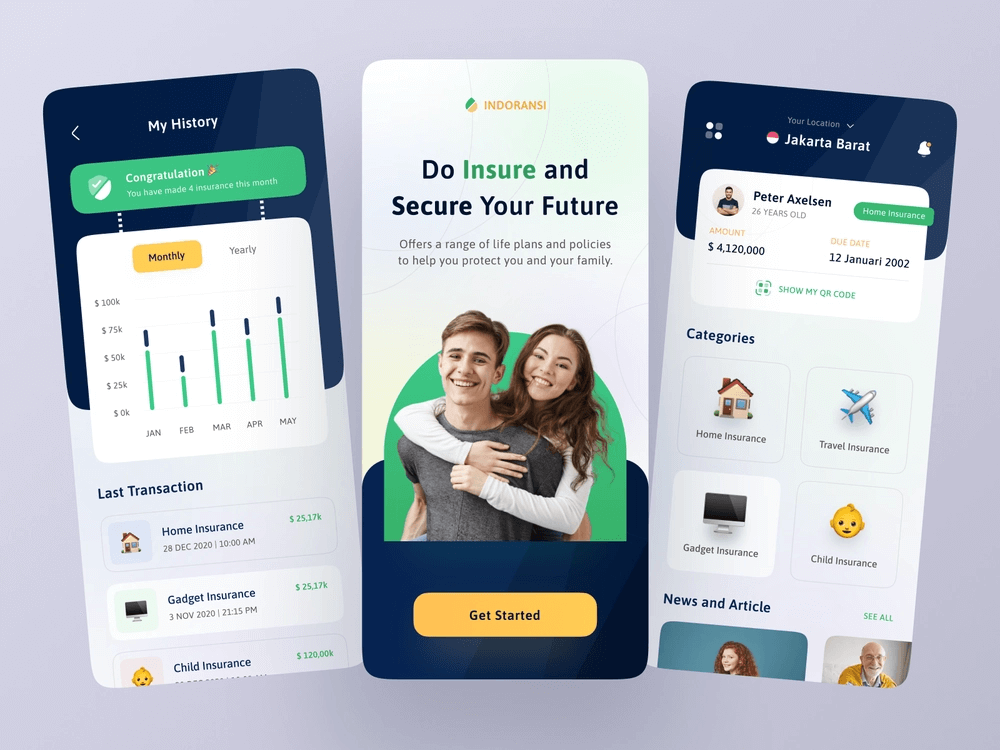
Pillar #2: Data Privacy
Health insurance apps deal with sensitive personal and medical information, so it’s essential to ensure that user data is protected from unauthorized access. This involves implementing strong encryption protocols and other security measures to safeguard user information. In addition, health insurance apps must comply with data protection laws and regulations to ensure that user privacy is respected.
Pillar #3: Proper App Functionalities
Functionality is an essential pillar of health insurance apps. These apps should provide users with a range of features that allow them to manage their healthcare needs effectively. This includes the ability to check coverage, track claims, and find healthcare providers. Health insurance apps should also be able to integrate with other apps and devices to provide a seamless user experience.
Health Care App Features
| Feature | Description |
|---|---|
| Provider Search | To find healthcare providers. |
| Claims Management | For managing insurance claims. |
| Telemedicine | For virtual doctor visits. |
| Health Risk Assessment | To assess health risks. |
| Medication Reminders | Reminder for medication. |
| Wellness Programs | Health and fitness programs. |
| Health Records | Access to medical records. |
| Emergency Services | Access emergency services. |
| Appointment Scheduling | Schedule doctor appointments. |
| Health Education | Health education resources. |
During insurance mobile application development there are immense features that need to be incorporated in order to attract audiences. We have outlined specific features that you should be present in your application to make it highly competitive.
Benefits of Health Insurance Apps
There are various benefits of health app development benefits that can provide support to patients as well as insurers. If you want to develop a new health insurance app then you should actively look toward the benefits that it can deliver.
Benefits for Patients
Health insurance apps are becoming increasingly important as more people seek to manage their health digitally.
- Easy access to healthcare information and services.
- Convenient appointment scheduling and prescription refills.
- Real-time updates on claim statuses and coverage information.
- Personalized health coaching and support.
- Integration with other health techs, such as wearables and glucose monitors.
- Improved patient engagement and satisfaction.
- Better health outcomes through proactive management of health conditions.
- Increased efficiency and cost savings for healthcare providers and insurers.
- Enhanced data security and privacy protection for user information.
- Improved communication and collaboration between patients and healthcare providers.
Benefits for Insurers
- Provide financial protection for unexpected medical costs.
- Encourage preventive care and early intervention.
- Help manage chronic conditions to improve health outcomes.
- Offer access to a network of healthcare providers and services.
- Provide support and guidance for navigating the healthcare system.
- Promote wellness through education and coaching.
- Streamline administrative processes for healthcare providers and patients.
- Contribute to a more efficient and cost-effective healthcare system.
- Promote transparency and accountability in healthcare.
- Offer peace of mind and security for individuals and families.
Read More: Chatbots in Healthcare
Stages for Health Insurance Application Development
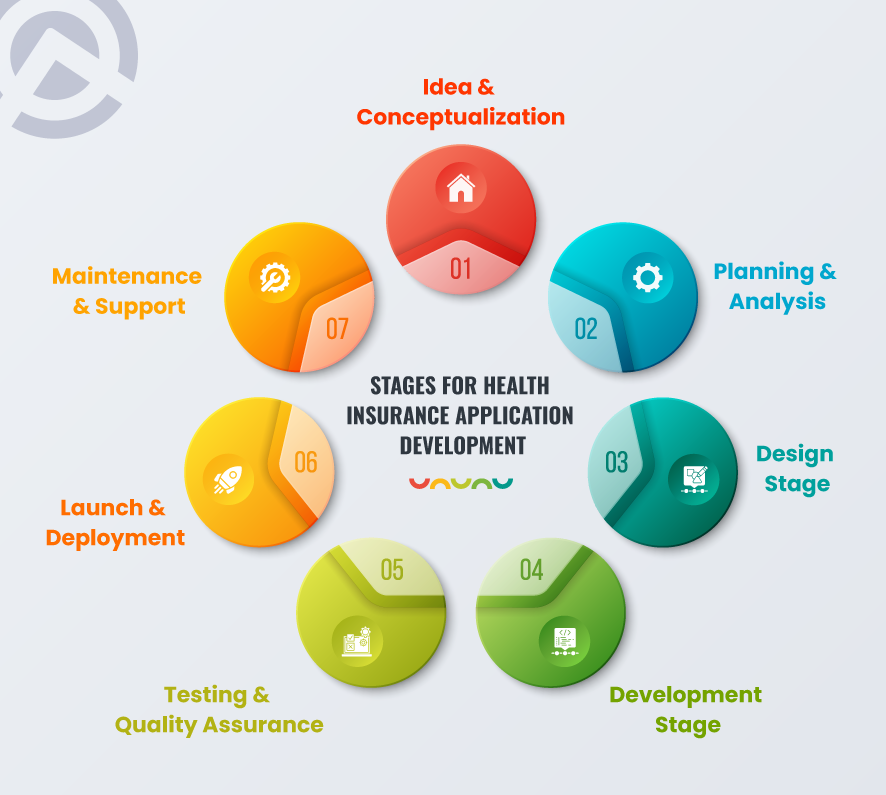
Developing a health insurance application involves multiple stages, each of which is critical to the application’s success. By following these steps and working closely with users, developers can create an application that meets the needs of its target audience and delivers a high level of functionality and user experience.
Step 1: Ideation and Conceptualization
The ideation and conceptualization stage is the starting point of health insurance application development. In this stage, the development team identifies the purpose of the application, its target audience, and its key features. The team conducts market research to analyze the competition and identify gaps in the market that the application can fill. The team also develops a rough plan for the application’s development and sets out its scope and requirements.
Step 2: Planning and Analysis
The planning and analysis stage involves creating a detailed plan for the development process. This includes setting timelines, budgets, and a roadmap for the project. During this stage, the team conducts a detailed analysis of the application’s requirements, user needs, and competitor offerings. The team also creates a user persona, which helps to guide the application’s design and development.
Step 3: Design
In the design stage, the development team creates wireframes, user interface designs and visual elements for the application. The team works to create a user-friendly and visually appealing design that meets the needs of the target audience. The team also designs the user flow and the application’s information architecture, ensuring that the application’s functionality is intuitive and easy to navigate.
If your health insurance app is already present in the live market then you can utilize our continuous product development services. Our developers will add additional functionalities and creative designs to your application so that it can deliver immense benefits to your targeted audience.
Step 4: Development
The development stage is where the actual coding and programming of the application takes place. The team uses the chosen technology stack to build the application’s features and functionality. This stage involves writing the code, integrating third-party APIs, testing, and debugging. The development team works closely with the design team to ensure that the application’s functionality aligns with its design.
Step 5: Testing and Quality Assurance
In the testing and quality assurance stage, the development team tests the application to ensure it meets the desired standards of quality and performance. This stage involves functional testing, integration testing, user acceptance testing, and performance testing. The team uses automated testing tools to speed up the testing process and ensure that the application works as intended.
Step 6: Launch and Deployment
Once the application has been thoroughly tested and approved, it is launched and made available to users. The development team prepares the application for deployment, ensuring that it meets the relevant standards and regulations. This stage involves finalizing the application’s documentation, such as the user manual and technical specifications. The development team may also work on marketing and promotion activities to raise awareness of the application.
Step 7: Maintenance and Support
After the application is launched, ongoing maintenance and support are required to ensure that it continues to function as intended. The development team monitors the application’s performance and addresses any bugs or issues that arise. The team also responds to user feedback and updates the application with new features and functionality. The maintenance and support stage is critical to the long-term success of the application, as it ensures that users are satisfied with the application’s performance and functionality.
Cost Estimation For Health & Medical Insurance
| Stage | Cost Factors | Estimated Cost | Impact Factors |
| Ideation and Conceptualization | Market research, feasibility analysis, concept design | $5,000 – $10,000 | Innovation, market differentiation, competitive edge |
| Planning and Analysis | Project planning, requirements gathering, risk analysis | $5,000 – $15,000 | Efficiency, clarity, alignment with business objectives |
| Design | User interface design, user experience, visual design | $10,000 – $15,000 | Usability, aesthetics, user engagement |
| Development | Software development, quality assurance, testing | $15,000 – $25,000 | Functionality, reliability, performance, security |
| Testing and Quality Assurance | Testing tools, testing infrastructure, bug fixing | $10,000 – $20,000 | User satisfaction, quality, error-free application |
| Launch and Deployment | Hosting, server management, app store submission | $5,000 – $10,000 | Market reach, user acquisition, business growth |
| Maintenance and Support | Bug fixes, feature updates, customer support | $5,000 – $20,000 | User retention, customer satisfaction, revenue growth |
The estimated cost for developing health insurance applications ranges from $55,000 to $125,000.
Note: The estimated costs listed in the table are not absolute figures and it may vary based on the specific needs and requirements of the health insurance application being developed. Although, if you will utilize MVP Development services then it can increase your overall cost.
Strategies to Select the Right Partner for Health Insurance App Development
Developing a health insurance app is a complex and time-consuming process that requires expertise and experience. Choosing the right partner for app development is crucial to ensure that the app meets your business goals and user requirements. Here are some strategies to select the right partner for health insurance app development:
1. Look for Experience and Expertise: When selecting a partner for health insurance app development, it’s essential to choose a company with experience in developing similar apps. Look for a partner who has worked on health insurance apps before and has a strong track record of delivering quality work.
2. Check Technical Capabilities: The technical capabilities of your app development partner play a critical role in the success of your health insurance app. Look for a partner with a team of skilled developers who are proficient in the latest technologies and programming languages.
3. Consider the Team Size: The size of the development team is another important factor to consider. A larger team may be able to deliver the app faster, but it can also lead to communication challenges and a lack of personal attention. On the other hand, a smaller team may be able to provide more personalized service but may take longer to deliver the app.
4. Check References and Reviews: Before selecting an app development partner, it’s essential to check their references and reviews. Look for feedback from their previous clients to get an idea of their performance and quality of work.
5. Consider the Cost: Cost is always a consideration when selecting a development partner. However, it’s essential to balance cost with the quality of work and expertise of the development team.
Read more: Boost in Online HealthCare due to Coronavirus
The Final Words
The development of a health insurance app is a challenging process that requires careful planning and execution. By following the stages outlined in this article and selecting the right partner, you can ensure the success of your project and deliver an app that meets the needs of your users.
Amplework Software offers end-to-end app development services for healthcare apps, software, enterprise solutions & many more. We follow a transparent project management process and ensure effective communication throughout the project’s duration. So, connect with our project managers and share your requirements to turn your app idea into reality.


 sales@amplework.com
sales@amplework.com
 (+91) 9636-962-228
(+91) 9636-962-228




